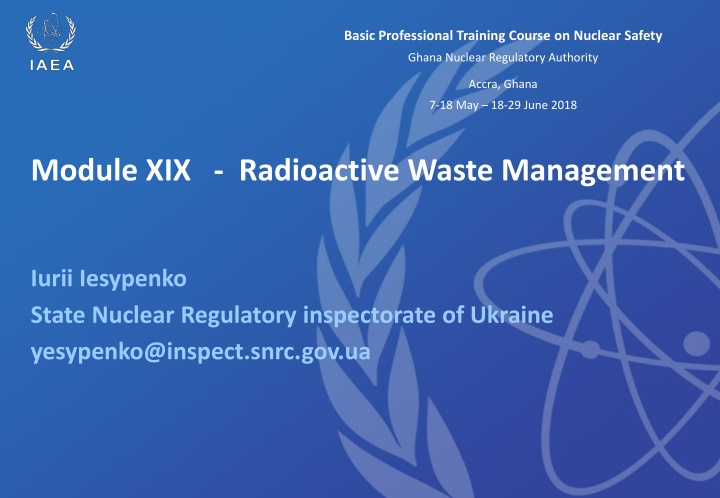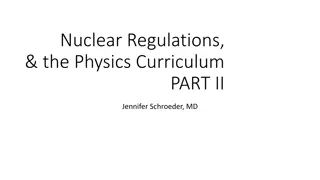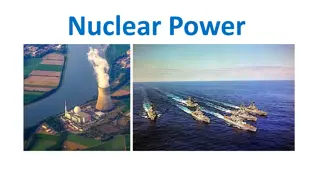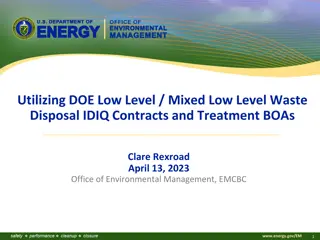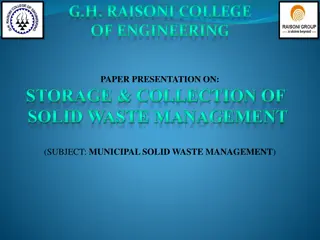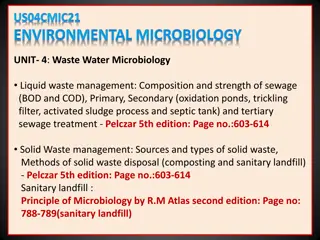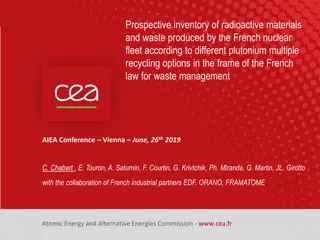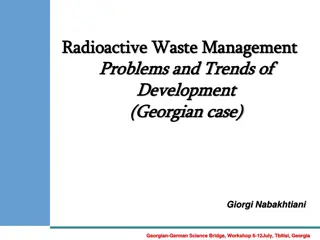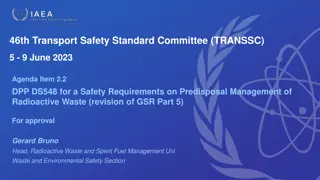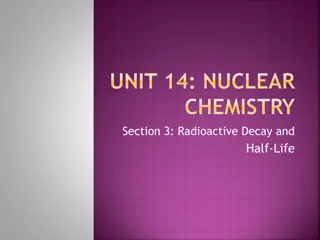Comprehensive Module on Radioactive Waste Management in Nuclear Safety Training
This module XIX on Radioactive Waste Management explores the generation, classification, treatment, storage, and disposal processes of radioactive waste. It covers the nature and sources of radioactive waste in medical, industrial, and research settings. The module also delves into the regulatory control of specific radioactive materials and their associated wastes. Understanding these concepts is crucial for maintaining nuclear safety and protecting public health.
Download Presentation

Please find below an Image/Link to download the presentation.
The content on the website is provided AS IS for your information and personal use only. It may not be sold, licensed, or shared on other websites without obtaining consent from the author.If you encounter any issues during the download, it is possible that the publisher has removed the file from their server.
You are allowed to download the files provided on this website for personal or commercial use, subject to the condition that they are used lawfully. All files are the property of their respective owners.
The content on the website is provided AS IS for your information and personal use only. It may not be sold, licensed, or shared on other websites without obtaining consent from the author.
E N D
Presentation Transcript
Basic Professional Training Course on Nuclear Safety Ghana Nuclear Regulatory Authority Accra, Ghana 7-18 May 18-29 June 2018 Module XIX - Radioactive Waste Management Iurii Iesypenko State Nuclear Regulatory inspectorate of Ukraine yesypenko@inspect.snrc.gov.ua
Lerning objectives After completing be able to: this Module, the trainee will 1. Explain in its own words the radioactive waste generation, treatment, storage and disposal process. 2. Understand the aim of the national radioactive waste policy and strategy. Module XIX Radioactive Waste Management 2
Contents 1 Radioactive waste generation 2 Waste Classification System 3 Nature and Sources of Radioactive Waste 4 Treatment 5 Waste Packaging 6 Storage and Disposal Module XIX Radioactive Waste Management 3 3
Radioactive waste (based on IAEA glossary) - waste that contains or is contaminated with radionuclides at concentrations or activities greater than clearance levels (as established by the regulatory body). The radioactive waste is produced in: medical, industrial, research facilities, nuclear facilities (nuclear power plants and fuel reprocessing facilities), uranium mining or naturally occurring. Certain kinds of radioactive materials, and the wastes produced from using these materials, are subject to regulatory control. Module XIX Radioactive Waste Management 4
Radioactive waste - medical At medical facilities, radioactive materials are used in numerous diagnostic and therapeutic procedures for patients test tubes, bottles, tubing and other objects come into contact with radioactive material. In medical research the animal remains containing the radioactive material become radioactive waste. Hospitals may store waste containing radioactive material: With short half-lives until it decays to background radiation levels for ultimate disposal with non-radioactive medical waste. Waste containing longer-lived radioactive material is stored or sent to a radioactive waste disposal facility. Module XIX Radioactive Waste Management 5
Radioactive waste - industrial In industry radioactive materials are used: to measure the thickness, density or volume of materials; to examine welds and structures for flaws; to analyse wells for oil and gas exploration; for various other types of research and development. Radioactive waste may also be produced during the manufacture of devices: certain gauges; luminous watches; exit signs; smoke detectors that contain radioactive material. Module XIX Radioactive Waste Management 6
Radioactive waste nuclear facilities Operation of a nuclear reactor generates radioactive waste: liquid (release to river, sea ), gaseous (release through the plant vent), solid (store on the site temporary, protective gloves, clothing and, occasionally, respiratory equipment), spent fuel (if declared as waste), waste from reprocessing (if spent fuel declared as reprocessing materials). Module XIX Radioactive Waste Management 7
Radioactive waste mining & milling Tailing wastes: are generated during the milling of ores to extract uranium and thorium. have relatively low concentrations of radioactive materials with long half-lives. contain radium, thorium, and small residual amounts of uranium that were not extracted during the milling process. The uranium mill tailings contain chemical and radiological material discarded from the mill. Radium and thorium, which are the dominant radioactive materials in mill tailings, have long half-lives (1,600 and 77,000 years respectively). Module XIX Radioactive Waste Management 8
Responsibilities in the waste management Operator is responsible for safety of the facilities. Carrying out safety assessment. Developing and maintaining a safety documentation in compliance with the regulatory requirements infrastructure. Module XIX Radioactive Waste Management 9
Responsibilities in the waste management Government and Regulatory body are responsible to: establish and maintain an appropriate governmental, legal and regulatory framework for radioactive waste management. perform the licensing process and inspection activities to ensure that the conditions are met. Module XIX Radioactive Waste Management 10
Waste management policy and strategy Joint Convention on the Safety of Spent Fuel Management and on the Safety of Radioactive Waste Management Member states must set spent fuel and radioactive waste management policies and strategies for radioactive waste a proper care is provided for radioactive waste. Module XIX Radioactive Waste Management 11
Waste management policy and strategy Responsibilities for national policy and strategy in radioactive waste management (IAEA NW-G-1.1): government, ministries, waste management, organization and radioactive waste producers. Optimal strategy should be determined by comparison of the relative advantages and disadvantages of each strategy option. Module XIX Radioactive Waste Management 12
International obligations Government Policy statement National circumstances National legislation RW Ministries Policy implementation RW management infrastructure Policy and Strategy Funding system RW management objectives Strategy implementation RW management organisation Resources Technical options RW producers Strategy adoption Preparedness for emergency situations Responsibility for safety Module XIX Radioactive Waste Management 13
Qestions 1. What do we call a Radioactive Waste? (three aspects) 2. What is the National strategy on radioactive waste management should be about? 3. What are national counterparts roles in RW management? Module XIX Radioactive Waste Management 15-26 January - 19-30 March 2018 14 14
WASTE CLASSIFICATION - Learning objectives 1. Get broad overview of the waste classification. 2. Understand the characteristics of the: exempt waste, very short lived waste, very low level waste, low level waste, intermediate level waste, high level waste. Module XIX Radioactive Waste Management 15
Waste classification - IAEA To uniform different terminology and safety measures in waste managing it was necessary to introduce uniform methodology for classifying radioactive waste according to the physical, chemical and radiological properties that are relevant to facilities or circumstances in which radioactive waste is generated and managed. Difference in terminology, in some instances, rise to difficulties in establishing consistent and coherent waste management policies and implementing strategies. Consistent classification of the radioactive waste was necessary to ensure easy communication on waste management practices on nationally and internationally level, particularly in the context of the Joint Convention on the Safety of Spent Fuel Management and on the Safety of Radioactive Waste Management. Module XIX Radioactive Waste Management 16
Waste classification - IAEA Many countries adopt a nationally uniform system of classification of radioactive waste in accordance with IAEA guidelines IAEA General Safety Guide Classification of Radioactive Waste (No. GSG- 1). It is important that all types of radioactive waste are correctly classified to ensure that appropriate disposal measures will be applied. The IAEA Safety Guide sets out non-prescriptive, best-practice guidance for classifying radioactive waste. Module XIX Radioactive Waste Management 17
Waste classification - IAEA The Safety Guide ensures appropriate flexibility to classify their waste in accordance with internationally accepted methods and terminology. Quantitative values of allowable activity content for each significant radionuclide are specified on the basis of safety assessments for individual disposal sites. Module XIX Radioactive Waste Management 18
Waste classification - IAEA Module XIX Radioactive Waste Management 19
Exempt waste (EW) Meets the criteria for clearance, exemption or exclusion from regulatory control for radiation protection purposes. Difference between exemption and clearance levels: exempt waste was never under regulatory control and clearance waste was under regulatory control but related to characteristics it was possible to clear it from regulatory control. Module XIX Radioactive Waste Management 20
Exempt waste (EW) IAEA Safety Standards Series, No. RS-G-1.7, Application of the Concepts of Exclusion, Exemption and Clearance (2004): provides explanation and guidance on the concepts of exclusion, exemption and clearance, gives values of activity concentration for radionuclides of both natural and artificial origin that may be used by the regulatory body for determining when control are not required. Module XIX Radioactive Waste Management 21
Criteria for exemption and clearance The values of activity concentration for artificial radionuclides are derived on the basis of generic scenarios for the recycling and disposal of waste: The effective doses to individuals should be of the order of 10 Sv or less in a year. The effective doses due to such low probability events should not exceed 1 mSv in a year. The regulatory body can establish different exempt levels. Radionuclides of natural origin The values are determined on the basis of consideration of the upper end of the worldwide distribution of activity concentrations in soil. Module XIX Radioactive Waste Management 22
Very short lived waste (VSLW) Waste that can be stored for decay over a limited period of up to a few years. Cleared from regulatory control for uncontrolled disposal, use or discharge. Containing primarily radionuclides with very short half- lives often used for research and medical purposes. Storage for decay is frequently used in the management of liquid and gaseous waste. Containing short half-life radionuclide half-lives of the order of 100 days or less. Module XIX Radioactive Waste Management 23
Very short lived waste (VSLW) The classification depends on the point in time at which the waste is assigned to classification. The classification scheme is not fixed but depends on the actual conditions of the waste in question at the time of assessment. Module XIX Radioactive Waste Management 24
Very low level waste (VLLW) Does not meet the criteria of EW and does not need a high level of containment and isolation and is suitable for disposal in near surfacelandfilltypefacilities with limited regulatory control. Soil and rubble with low levels of activity concentration slightly above the levels specified for the clearance. Acceptancecriteria for engineered specialized surface landfill type facilities: described in the IAEA Safety Standards Series, No. RS-G-1.7, are developed based on a safety assessment for a specific facility, approved by the regulatory body. Module XIX Radioactive Waste Management 25
Very low level waste (VLLW) A landfill facility can safely accommodate waste containing artificial radionuclides with levels of activity concentrations one or two orders of magnitude above the levels for exempt waste, for waste containing short lived radionuclides and with limited total activity. Up to site factors and the design, it is possible also to manage waste with higher levels of activity concentration. Module XIX Radioactive Waste Management 26
Low level waste (LLW) Above clearance levels, but with limited amounts of long lived radionuclides. Requires shielding but needs little or no provision for heat dissipation. Short lived radionuclides at higher levels of activity concentration or long lived radionuclides, but only at relatively low levels of activity concentration. Module XIX Radioactive Waste Management 27
Low level waste (LLW) Suitable for near surface disposal. Various design options for near surface disposal facilities: from simple to more complex engineered facilities, involve disposal at varying depths, typically from the surface down to 30 m. Classification of waste as LLW relates to the particular radionuclides in the waste, and the various exposure pathways, such as ingestion and inhalation should be taken in account. Module XIX Radioactive Waste Management 28
Low level waste (LLW) The design of disposal is based on the need for institutional control so that human intrusion into the waste is prevented. In many States it is assumed that institutional controls can be relied upon for a period of up to around 300 years. Bounding values for LLW in terms of activity concentration levels is derived by estimating doses to exposed individuals after this period of institutional control. Module XIX Radioactive Waste Management 29
Intermediate level waste (ILW) Waste that requires a greater degree of containment and isolation than that provided by near surface disposal. Needs no provision, or only limited provision, for heat dissipation during its storage and disposal. May contain long lived radionuclides, so requires disposal at greater depths, of the order of tens of metres to a few hundred metres. Disposal at relevant depth provides a adequate period of isolation from the environment if both the natural barriers and the engineered barriers of the disposal system are selected properly. At the same time it reduces an inadvertent human intrusion. Module XIX Radioactive Waste Management 30
Intermediate level waste (ILW) A precise boundary between LLW and ILW cannot be provided, as limits on the acceptable level of activity concentration will differ between individual radionuclides or groups of radionuclides. Contents of intermediate level waste drum. Module XIX Radioactive Waste Management 31
Intermediate level waste (ILW) Waste acceptance criteria for a near surface disposal facility is dependent on the actual design of and planning for the facility. Restrictions on levels of activity concentration for long lived radionuclides in individual waste packages may be complemented: by restrictions on average levels of activity concentration, by emplacement of waste packages with higher levels of activity concentration at selected locations within Module XIX Radioactive Waste Management the disposal facility. 32
High level waste (HLW) Contains such large concentrations of both short and long lived radionuclides. Typical levels of activity concentration in the range of 104- 106 TBq/m3. Generates significant quantities of heat from radioactive decay, and normally continues to generate heat for several centuries. A greater degree of containment and isolation from the accessible environment deep geological disposal, with engineered barriers. Module XIX Radioactive Waste Management 33
Radioactive waste High Level Waste Figure: High-level radioactive waste repository Module XIX Radioactive Waste Management 34
Waste classification - Germany Module XIX Radioactive Waste Management 35
Waste classification - USA Classification of the radioactive waste in the USA: Class A waste is waste that is usually segregated from other waste classes at the disposal site. Class B waste is waste that must meet more rigorous requirements on waste form to ensure stability after disposal. Class C waste is waste that not only must meet more rigorous requirements on waste form to ensure stability but also requires additional measures at the disposal facility to protect against inadvertent intrusion. Waste that is not generally acceptable for near-surface disposal is waste for which form and disposal methods must be different, and in general more stringent, than those specified for Class C waste. In the absence of specific requirements in this part, such waste must be disposed of in a geologic. Module XIX Radioactive Waste Management 36
Waste classification - Ukraine Depending on specific activity, three categories are introduced for solid and liquid radwaste Classification of radwaste with unknown radionuclide composition and unknown specific activity by criteria of air absorbed dose at distance of 0.1 m Module XIX Radioactive Waste Management 37
NATURE AND SOURCES OF RADIOACTIVE WASTE - Learning objectives 1.Get broad overview of the types of radioactive waste. 2.Get broad overview of the generating liquid radioactive waste. 3.Get broad overview of the generating solid radioactive waste. 4.Get broad overview of the generating gaseous radioactive waste. Module XIX Radioactive Waste Management 38
Types of radioactive waste The radioactive waste may be solid, liquid or gaseous. Levels of activity concentration range from extremely high levels (spent fuel) to very low levels. Radioactive Waste could come from: mining and minerals processing NPPs institutional activities defence programmes and weapons production related waste Module XIX Radioactive Waste Management 39
Waste from mining and minerals processing Mining activities lead to large amounts of materials that contain uranium or thorium in small quantities. Mine tailings resulting from the mining of uranium and thorium ores contain elevated levels of naturally occurring radionuclides and are required to be managed as radioactive waste. Tailings from processing contain significant amounts of hazardous chemicals (copper, arsenic, molybdenum and vanadium) considered in assessing the safety of planned management options. Module XIX Radioactive Waste Management 40
Waste from mining and minerals processing Radioactive waste containing naturally occurring radionuclides also arise from the extraction and/or processing of other materials that happen to be rich in naturally occurring radioactive materials; phosphate minerals, mineral sands, some gold-bearing rocks, coal and hydrocarbons, and contain long lived radionuclides at relatively low concentrations. The concentration of the radionuclides in these waste streams may exceed the levels for exempt waste so the regulatory control is necessary to ensure safety. Module XIX Radioactive Waste Management 41
Waste from NPPs Low level waste and intermediate level waste from operations: purification, conversion and enrichment of uranium and fabrication, filter materials, lightly contaminated trash, and residues from recycling, uranium and plutonium (in the case of mixed oxide fuel) are characteristic radionuclides in this waste. Module XIX Radioactive Waste Management 42
Waste from NPPs Waste from decommissioning of nuclear installations: radioactive waste that may vary greatly in type, level of activity concentration, size and volume, and may be activated or contaminated, solid materials such as process equipment, construction materials, tools and soils, the largest volumes of waste will mainly be VLLW and LLW, to reduce the amount, decontamination of materials is widely applied. Module XIX Radioactive Waste Management 43
Waste from NPPs High level waste: spent nuclear fuel generates significant heat and is usually placed in storage pools, spent fuel can be subjected to a reprocessing, disposal or long term storage. Liquid HLW: stored in tanks prior to its eventual solidification, general agreement that liquid HLW needs to be transformed into a solid, somwhere liquid HLW has been stored in tanks for time periods now extending to several decades. Module XIX Radioactive Waste Management 44
Waste from institutional activities Wastefromresearchreactors: generated by research reactors, some disused radioactive sources, does not meet the waste acceptance criteria of near surface disposal facilities. Module XIX Radioactive Waste Management 45
Waste from institutional activities Wastefromresearchfacilities: hot cell chains, glove box chains or pilot plants for checking fuel fabrication processes, for fuel reprocessing, and for post-irradiation examinations, as well as their analytical laboratories, presence of non-negligible amounts of long lived alpha emitters, generally belongs to the ILW, in some circumstances, to the HLW class, the type and volume of waste dependent on the research conducted. Module XIX Radioactive Waste Management 46
Waste from the production and use of radioisotopes Productionofradioisotopes: type and volume of waste generated depends on the radioisotope and its production method, the volume of radioactive waste generated from these activities is small but the levels of activity concentration may be significant. Disusedsealedsources: sealed sources are widely used in medical and industrial applications, large and highly concentrated amount of single radionuclide, require emplacement at greater depths and fall within ILW class. Module XIX Radioactive Waste Management 47
Waste from defence programmes and weapons production related waste In the early days of nuclear programs large quantity of radioactive waste was generated. A lot of HLW is still in storages awaiting solidification. At the end of last century considerable amount of nuclear weapons were dismantled. Blending of highly enriched uranium or plutonium with natural uranium to produce uranium or mixed uranium-plutonium fuel: for commercial reactors or storing this material for future disposal with HLW or spent fuel. Module XIX Radioactive Waste Management 48
Contaminations Radioactive residues deposited on Earth s surface from: nuclear weapon testing, accidents at nuclear facilities and some past practices like uranium mining. The waste arising from remediation operations will have to be managed as radioactive waste stabilized in situ or disposed of in appropriate disposal facilities. Module XIX Radioactive Waste Management 49
TREATMENT - Learning objectives 1.Get broad overview of the waste treatment and conditioning. 2.Get broad overview of the techniques for the waste treatment and conditioning. Module XIX Radioactive Waste Management 50
